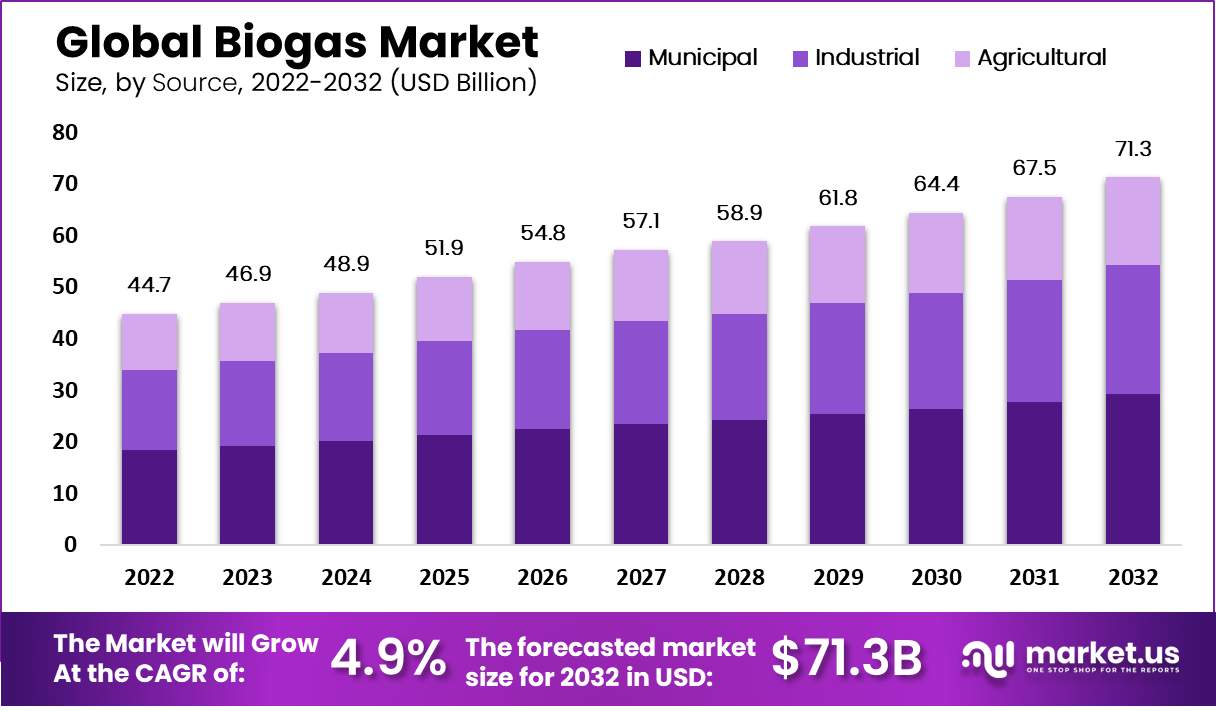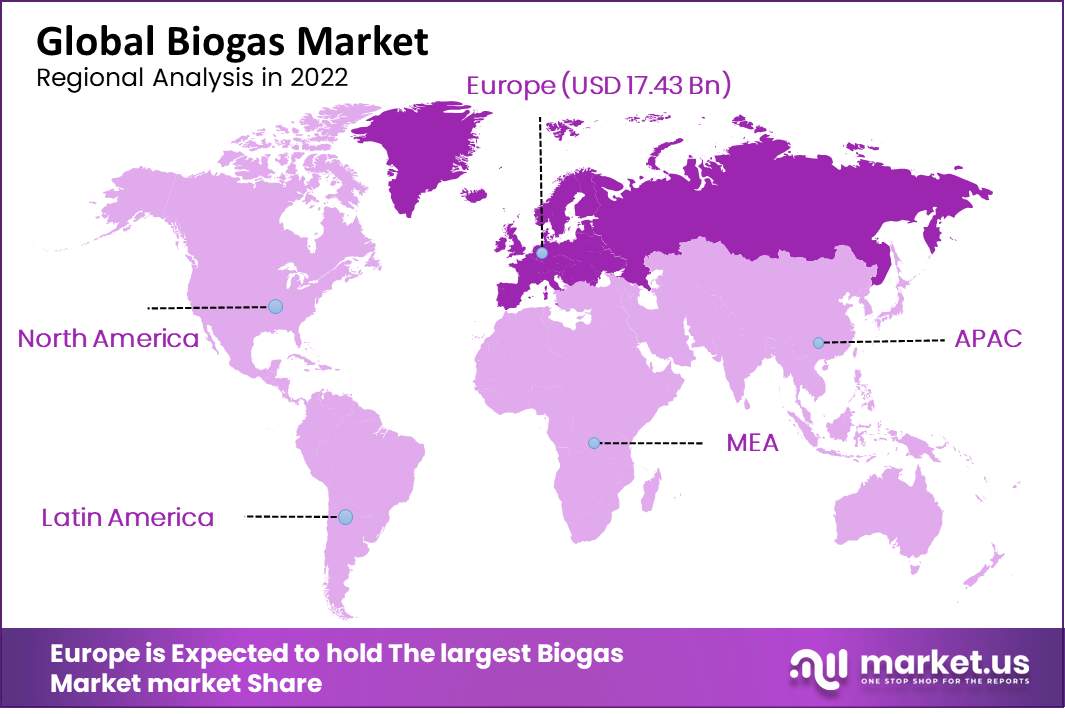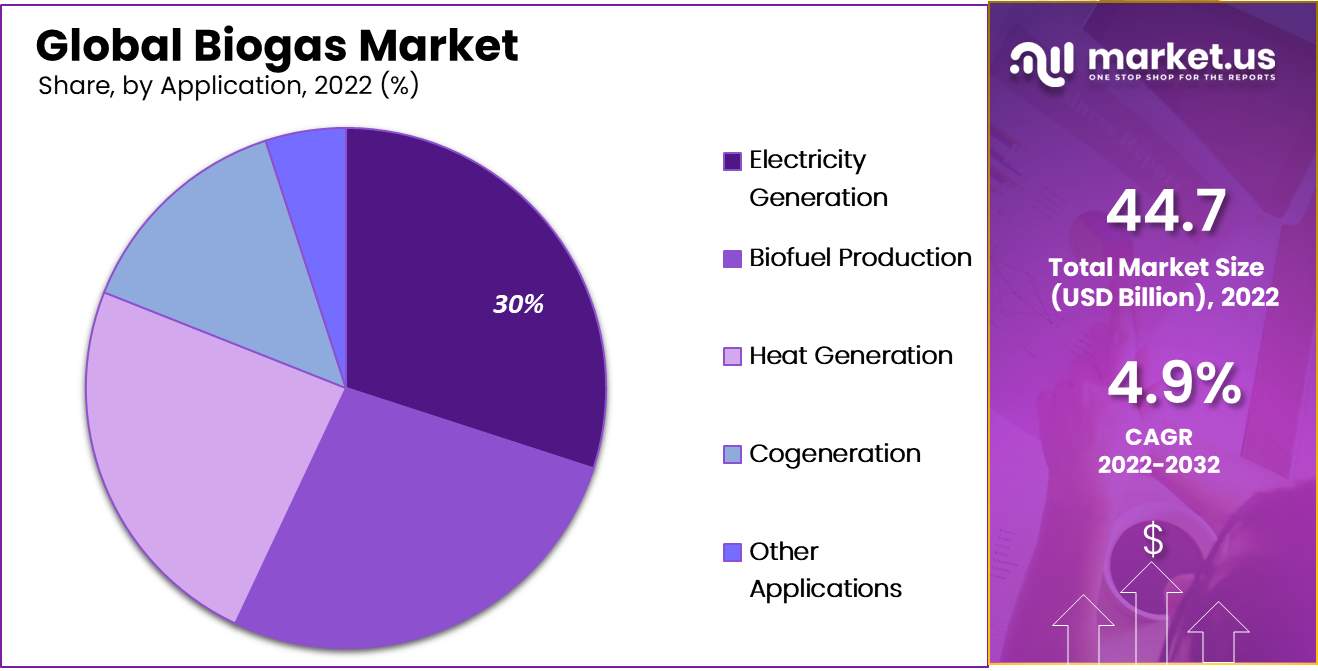New York, Jan. 04, 2024 (GLOBE NEWSWIRE) -- According to market.us, the Global Biogas Market reached USD 46.9 billion in 2023 and is projected to witness substantial growth, reaching approximately USD 71.3 billion by 2032. From 2023 to 2032, this market is anticipated to experience its highest compound annual growth rate (CAGR) at 4.9%.
The biogas market represents a sector dedicated to the production, refinement, and utilization of biogas - a renewable energy source generated through the anaerobic digestion of organic materials like agricultural waste, animal manure, food waste, sewage, and energy crops. This biological process breaks down organic matter in an oxygen-deprived environment, releasing a mixture primarily composed of methane and carbon dioxide. Biogas, a versatile and eco-friendly fuel, can be utilized for electricity generation, heating, or as a vehicle fuel.

Want to Access the Statistical Data and Graphs, Request PDF Sample @ https://market.us/report/biogas-market/request-sample
Moreover, the refinement of biogas into biomethane, a purified form of methane, enhances its quality, making it suitable for injection into natural gas grids or as a cleaner alternative for transportation fuel. The biogas market is continually expanding due to its role in fostering sustainable waste management practices, reducing greenhouse gas emissions, and contributing to the transition towards a more diversified and environmentally friendly energy mix. This growth is further supported by governmental policies incentivizing renewable energy adoption and the increasing focus on circular economy principles.
Key Takeaway
- Market Growth Projection: The global biogas market is estimated to increase from USD 44.7 billion in 2022 to approximately USD 71.3 billion by 2032, marking a projected Compound Annual Growth Rate (CAGR) of 4.9% between 2023 and 2032.
- Biogas Composition: Typically consisting of 50-70% methane and 30-50% carbon dioxide, biogas is primarily produced through the anaerobic digestion or fermentation of organic materials.
- Driving Factors: Environmental concerns, supportive government policies, economic advantages, and incentives drive the growth of the biogas market. Financial incentives offered by governments aim to reduce the capital costs associated with biogas production, fostering its market entry.
- Sources of Biogas: The main sources include municipal waste (like food scraps and yard debris), industrial facilities (such as distilleries and food processing plants), and agricultural sources (like manure, energy crops, and residues).
- Applications: Biogas finds diverse applications including electricity generation (constituting 30% of the market in 2022), biofuel production, heat generation, cogeneration, and other uses like cooking and lighting in developing nations.
- Regional Dominance: Europe holds the largest market share (39%), propelled by technological advancements and increased investments in refinery industries. Italy, in particular, is focused on decarbonization efforts.
- Major Players: Key companies like Air Liquide, PlanET Biogas, Wartsila, EnviTech Biogas AG, Robert Bosch GmbH, and Schmack Biogas GmbH lead the market with full-scale manufacturing capabilities and innovative biogas generation methods.
- Recent Developments: The industry has seen significant agreements for power purchases, investments in compressed biogas (CBG) plants, and the adoption of advanced technologies like AI and machine learning to enhance productivity.
- Challenges and Opportunities: While infrastructure limitations, high capital costs for small-scale projects, and reliance on organic feedstocks pose challenges, increasing demand for renewable energies, government incentives, technological advancements, and expanding applications present growth opportunities.
- Regional Analysis: Europe, especially countries like Italy, Germany, France, and the UK, dominates the market, but regions across North America, APAC, Latin America, and MEA also showcase substantial growth potential.
Factors are contributing to the growth and evolution of the Biogas Market
The growth and evolution of the biogas market within the green and renewable energy industry stem from several interconnected factors. Firstly, increasing environmental concerns and the urgent need to reduce greenhouse gas emissions have elevated the significance of sustainable energy sources. Biogas, produced from organic waste, stands out as a renewable energy solution that not only generates power but also curtails methane emissions, a potent greenhouse gas.
Additionally, governmental initiatives promoting renewable energy adoption and stricter regulations on waste management encourage the development of biogas infrastructure. This is further bolstered by advancements in technology, enhancing the efficiency of biogas production and purification processes, making it a more economically viable and attractive energy option. The circular economy principles emphasizing resource efficiency and waste valorization also drive the growth of biogas by turning organic waste into a valuable energy source while producing beneficial byproducts for agriculture.
Moreover, as societies increasingly prioritize sustainable energy practices, the market demand for biogas continues to rise, fueling investments and innovation within the sector. This convergence of environmental imperatives, technological advancements, regulatory support, and market demand underscores the pivotal role of biogas in the green and renewable energy industry's ongoing transformation
Top Trends in the Global Biogas Market
- Expansion of Feedstock Diversity: The market is witnessing an increase in feedstock diversity, including agricultural residues, organic waste, energy crops, algae, and sewage, broadening the sources for biogas production and enhancing market potential.
- Technological Advancements: Ongoing innovations in anaerobic digestion processes and biogas purification techniques are enhancing efficiency, increasing biogas yields, and improving the quality of biomethane produced, boosting the overall market competitiveness.
- Biomethane Injection into Gas Grids: The refinement of biogas into biomethane suitable for injection into natural gas grids is gaining traction, providing an eco-friendly and renewable source of gas for residential, commercial, and industrial use.
- Circular Economy Initiatives: The emphasis on circular economy principles encourages waste valorization and resource recovery. Biogas production not only generates energy but also yields nutrient-rich digestate used as a biofertilizer, supporting agricultural sustainability.
- Policy Support and Incentives: Governmental policies, subsidies, and support schemes promoting renewable energy adoption, waste management, and reduction of greenhouse gas emissions are driving market growth and encouraging investment in biogas projects.
Regional Analysis
Europe dominates with a 39% market share due to technological advancements and increased investments in refinery industries. Italy, for instance, is emphasizing market decarbonization efforts, driving significant acquisitions in the biogas realm. In terms of key regions and countries, Europe leads, followed by North America, Asia-Pacific (APAC), Latin America, and the Middle East & Africa (MEA). Specifically, Italy's efforts in biogas reflect its pursuit of decarbonization, with government initiatives propelling market growth.

Gain expert insights and supercharge your growth strategies. Request our market overview sample now
Competitive Landscape
The competitive landscape of the market has also been examined in this report. Some of the major players include:
- Agrinz Technologies GmbH
- Air Liquide
- DMT International
- Gasum Oy
- Home Biogas Inc.
- PlanET Biogas
- Scandinavian Biogas Fuels International AB
- Schmack Biogas Service
- Total
- Xebec Adsorption Inc.
- Other Key Players
Scope of the Report
| Report Attributes | Details |
| Market Value (2022) | USD 44.7 Billion |
| Forecast Revenue 2032 | USD 71.3 Billion |
| CAGR (2023 to 2032) | 4.9% |
| Europe Revenue Share | 39% |
| Base Year | 2023 |
| Historic Period | 2018 to 2022 |
| Forecast Year | 2023 to 2032 |
Market Drivers
- Government Policies and Regulations: Policies supporting renewable energy, waste management, and greenhouse gas reduction are significant drivers. Incentives, subsidies, and mandates for biogas production encourage its adoption.
- Environmental Concerns: Increasing awareness of climate change and the need for sustainable energy sources drives interest in biogas. Its ability to mitigate greenhouse gas emissions by capturing methane from organic waste is a significant factor.
- Energy Security: Biogas offers a renewable energy source that reduces reliance on finite fossil fuels, contributing to energy diversification and security.
- Waste Management Needs: Growing concerns over waste disposal drive the development of biogas facilities, utilizing organic waste from various sources such as agriculture, municipal waste, and wastewater treatment plants.
- Technological Advancements: Innovations in biogas production technology, such as improved anaerobic digestion processes, biomethane purification, and storage, contribute to market growth by enhancing efficiency and output.
Elevate Your Business Strategy! Purchase the Report for Market-Driven Insights: https://market.us/purchase-report/?report_id=26684
Market Restraints
- High Initial Investment: Setting up biogas facilities requires substantial initial capital investment for equipment, infrastructure, and technology. This cost can be a significant barrier, especially for smaller-scale projects or in regions with limited funding.
- Technical Challenges: Biogas production involves complex processes, and technical challenges like process efficiency, feedstock availability, and variability can affect output and reliability. Managing these intricacies requires expertise and ongoing maintenance.
- Competition with Other Energy Sources: Biogas faces competition from established energy sources like natural gas and coal. If these conventional energy sources remain economically competitive or if policies don't favor renewable energy, it can hinder biogas market growth.
- Infrastructure and Distribution Constraints: Developing a comprehensive distribution infrastructure for biogas, including transportation and storage facilities, can be challenging. Existing infrastructure might not support the widespread distribution of biogas-derived energy.
- Feedstock Availability and Quality: The consistent availability and quality of organic waste or feedstock required for biogas production can be uncertain. Dependence on agricultural residues, municipal waste, or other organic materials might face fluctuations due to seasonal variations or regulatory changes.
Market Opportunities
- Rising Energy Demand: With the global demand for energy increasing, particularly in emerging economies, there's a significant opportunity for biogas to contribute to the energy mix as a renewable and sustainable source.
- Circular Economy Initiatives: The push for circular economy models presents an opportunity for biogas production, as it involves converting organic waste streams into valuable energy, reducing waste and promoting resource efficiency.
- Urbanization and Waste Management: As urban populations grow, the need for effective waste management solutions rises. Biogas facilities can help in managing organic waste from municipalities, wastewater treatment plants, and industries, providing a sustainable waste-to-energy solution.
- Decentralized Energy Production: Biogas offers the potential for decentralized energy production, allowing smaller-scale facilities to cater to local energy needs. This can enhance energy security and reduce transmission losses associated with centralized power plants.
- Technological Innovations: Ongoing advancements in biogas production technologies, including improved anaerobic digestion processes, biogas upgrading, and utilization technologies, present opportunities to enhance efficiency and diversify biogas applications.
Report Segmentation of the Biogas Market
By Source Analysis
This market's sources include municipal, industrial, and agricultural sectors, with municipal waste contributing significantly, occupying a 41% market share. This waste encompasses food scraps, yard debris, and other organic materials processed through anaerobic digesters into biogas. Additionally, industries like distilleries and food processing plants are pivotal contributors, generating substantial organic waste suitable for biogas production. In agriculture, manure and energy crops play a critical role in biogas creation.
The market's robustness stems from its diverse applications: electricity generation holds a substantial 30.0% market share. Biogas powers homes and businesses, and the grid is extracted through gas engines or turbines. It's also pivotal in biofuel production, heat generation for industrial processes and space heating, as well as cogeneration, simultaneously producing electricity and heat. This versatility positions biogas as an ideal fuel for various applications, from powering communities to aiding cooking and lighting in regions lacking conventional energy access.
By Application Analysis
- Electricity Generation: As of 2022, electricity generation accounted for a substantial 30% market share. Biogas serves as a pivotal source for producing electricity via gas engines or turbines. This electricity powers various entities, including homes, and businesses, and even gets distributed into wider grids for community consumption.
- Biofuel Production: Biogas, enriched with biomethane or compressed natural gas (CNG), can be extracted for diverse biofuel products. The versatile nature of biogas contributes significantly to the biofuel sector, aiding in the creation of eco-friendly fuel alternatives.
- Heat Generation: Industrial processes and residential heating systems benefit from biogas as a source of heat. Its application extends to space heating in buildings, providing an efficient and sustainable heating solution.
- Cogeneration (Combined Heat and Power - CHP): This method involves the simultaneous production of electricity and heat. Biogas stands out as an ideal fuel for CHP systems due to its capacity to generate both forms of energy concurrently. This application finds use not only in electricity but also in cooking and lighting in regions with limited access to traditional energy sources.

Key Market Segments
Based on Source
- Municipal-
- Landfill
- Wastewater
- Industrial-
- Food Scrap
- Wastewater
- Agricultural-
- Dairy
- Poultry
- Swine Farm
- Agricultural Residue
Based on Application
- Electricity Generation
- Biofuel Production
- Heat Generation
- Cogeneration
- Other Applications
By Geography
- North America
- The US
- Canada
- Europe
- Germany
- France
- The UK
- Spain
- Italy
- Russia
- Netherland
- Rest of Europe
- APAC
- China
- Japan
- South Korea
- India
- Australia
- New Zealand
- Singapore
- Thailand
- Vietnam
- Rest of APAC
- Latin America
- Brazil
- Mexico
- Rest of Latin America
- Middle East & Africa
- South Africa
- Saudi Arabia
- UAE
- Rest of MEA
Recent Developments
- In January 2022: Bio Construct announced in January 2022 that it had entered into a Power Purchase Agreement (PPA) for electricity with Next Craftwork, a German trading company based in Cologne. Next Craftwork will market 40,000MWh of biogas-generated electricity under the agreement. Bio Construct will be responsible for delivering electricity to its customers from the biogas plants. The fixed-price PPA involves 86 biogas CHPs.
- In May 2022: InterTech Fuel Solutions announced that it will invest INR 600 billion in its venture into compressed Biogas (CBG). The investment will be made in CBG across India next year. The project will be developed in phases. The first phase will see the establishment of four CBG plants each in Gujarat, Uttar Pradesh Punjab, and Haryana.
Browse More Related Reports
- Solid Oxide Fuel Cells Market size is expected to be worth around USD 21.3 billion by 2033, from USD 1.4 billion in 2023, growing at a CAGR of 31.3% during the forecast period from 2023 to 2033.
- Hydrogen Fuel Cells Market was valued at USD 14.3 billion in 2023, this market is estimated to register a CAGR of 21.5% and is expected to reach USD 95.5 billion during the forecasted period of 2023 to 2032.
- Biodiesel Market size is expected to be worth around USD 101.6 billion by 2033, from USD 38.8 billion in 2023, growing at a CAGR of 10.1%
- Battery Energy Storage Systems market size is expected to be worth around USD 56.2 Bn by 2033, from USD 5.4 Bn in 2023, at a CAGR of 26.4%
- Green Chemicals Market was valued at USD 100.9 Bn and is expected to reach USD 274.2 Bn in 2032, Between 2023 and 2032, At a CAGR of 10.8%
- Variable Frequency Drives market size is expected to be worth around USD 37.6 Bn by 2033, from USD 23.3 Bn in 2023, at a CAGR of 4.9%
- Needle Coke Market size is expected to be worth around USD 7.1 billion by 2033, from USD 2.77 billion in 2023, growing at a CAGR of 9.9%
- Steam Turbine Market size is expected to be worth around USD 23.5 billion by 2033, from USD 17.8 billion in 2023, at a CAGR of 2.8%
About Us:
Market.US (Powered by Prudour Pvt Ltd) specializes in in-depth market research and analysis and has been proving its mettle as a consulting and customized market research company, apart from being a much sought-after syndicated market research report-providing firm. Market.US provides customization to suit any specific or unique requirement and tailor-makes reports as per request. We go beyond boundaries to take analytics, analysis, study, and outlook to newer heights and broader horizons.
Follow Us on LinkedIn
Our Blog:
